| 1 | Golden-crowned snake |
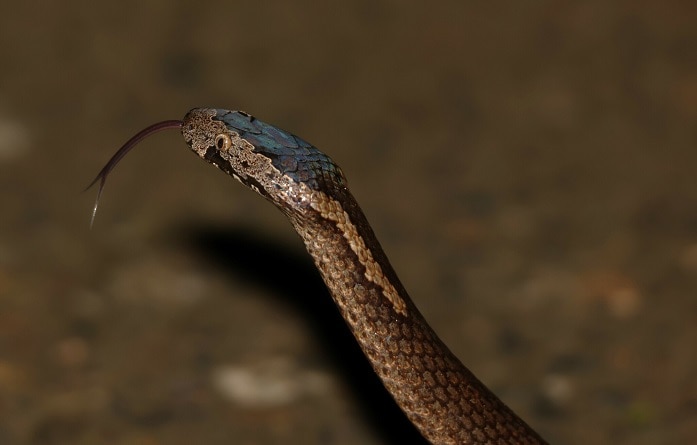
Everyone knows about the eastern brown snake or tiger snake, but Australia contains dozens of lesser known snake species, many of which are common, yet have successfully avoided the public limelight. One is the 50cm golden-crowned snake (Cacophis squamulosus), which is abundant along the east coast, including near Brisbane and Sydney.
This shy species is fully nocturnal, and reaches a maximum of 98cm. In the wild, golden crowned snakes inhabit rainforests and wet sclerophyll forests. However, they can thrive in suburban Sydney if water sources are nearby, and are sometimes spotted crossing roads at midnight, or even dragged in by hungry cats.
This snake has an odd defensive display, as when cornered, it thrashes its body around wildly, while pointing its head sharply downwards. It’s theorised that this is to display the namesake light crown on the head. They also do the opposite: they rear the upper third of their body up like a cobra, while kinking their neck into an S-shape. Golden crowned snakes will make sharp strikes repeatedly, but usually with their mouth closed.
Golden crowned snakes are mildly venomous, but have never killed a human. The vast majority of their diet consists of skinks such as sunskinks (Lampropholis), and occasionally frogs, toads and blind snakes. They completely ignore geckos, according to a 1980 study which dissected preserved museum specimens. This is an egg-laying species, producing an average of 6 per clutch. Hatchlings measure 16cm on average.
| 2 | Marsh snake |
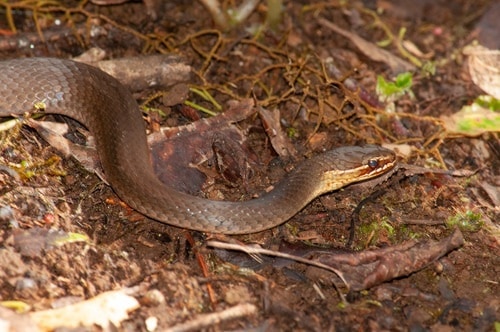
Another east coast snake, but this time diurnal rather than nocturnal. The marsh snake (Hemiaspis signata) is a peaceful species which often gathers together in small congregations, for reasons not currently understood.
Marsh snakes average at 50cm, but occasionally break the 1 metre barrier. They inhabit marshland and wet forests, and occupy many locations in suburban Sydney, including Northbridge golf course, Cooper’s Park at Belleview Hill, and the Artarmon railway line. A pale white line spreading from the mouth, and another from the eye, is a signature ID sign of this snake.
Hemiaspis signata is mildly venomous, but incapable of killing humans, as most bite reports merely describe local swelling. One boy developed moderately reduced fibrinogen levels and increased fibrinogen degradation products, hinting at coagulopathy (blood clotting disruption).
Marsh snakes mainly prey on skinks such as the three-toed skink (Saiphos equalis), which they immobilise with venom, then drag to a safe location (like long grasses) to swallow in peace. Again, this species shuns geckos, eating them only rarely, as they comprise less than 1% of their overall diet.
| 3 | Slatey grey snake |
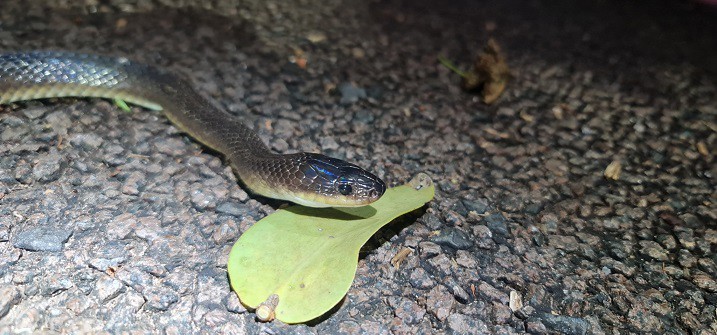
A species with a specialised diet: reptile eggs, including those of fellow snakes. The slatey grey snake (Stegonotus australis) inhabits moist forests in the far north of Australia, specifically two regions: Northern Territory and Queensland, where they’re relatively common. They reach a maximum length of 130cm, and while possessing only a mild venom, they can bite humans hard if manhandled, or purposefully release an intolerable snake stench.
According to a 2009 study from Queensland, which found slatey grey snakes by repeatedly driving along rainforest roads, their favourite eggs were those of the Boyd’s forest dragon and eastern water dragon. Among snakes, they’re particularly addicted to eggs of the common keelback and Lesser Sunda blind snake.
They aren’t limited to eggs either, as other confirmed prey include swampland lashtail dragons, banded tree monitors, and prickly forest skinks. They occasionally prey on rats and amphibians, but the reptile world is clearly their area of expertise.
Male slatey grey snakes are significantly longer than females. Originally, this species was dubbed Stegnotus cucullatus, but that name now only applies to those in Indonesia West Papua. Many old Australian studies are still listed under the S. cucullatus name.
| 4 | White-lipped snake |
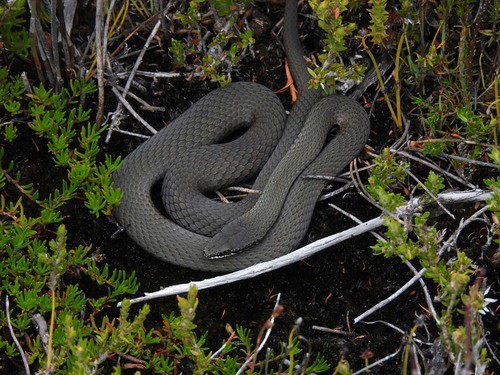
A common species of mild Victoria in Australia’s far south. The white-lipped snake (Drysdalia coronoides) is a short species with a maximum length of 45cm, and is one of Australia’s most cold-adapted snake. They’re particularly common around Melbourne, and are one of just three snake species native to Tasmania, alongside the tiger snake and lowland copperhead. Drysdalia coronoides has even been found near the summit of Mount Kosciuszko, Australia’s highest mainland mountain at 2,228 metres.
This snake is a car tyre black contrasting vividly against a snowy white lip line. Their venom is confirmed to contain neurotoxins, specifically a unique post-synaptic neurotoxin named drysdalin. However, their venom yield is just 2-3mg, and their fangs are especially small. No human deaths are confirmed.
A 1981 study analysed the white-lipped snake’s diet. Of 61 prey discovered, there was just 1 mammal and 3 frogs. The overwhelming majority consisted of lizards, mainly skinks, including rainbow skinks, southern grass skinks, and Spencer’s widow-eyed skinks. 6 reptile eggs were also discovered.
While white-lipped snakes just about reach Sydney, this lies at the extreme northeastern extent of their territory. Uncommonly for an Australian snake, this species produces live young (usually 3-5), although it’s been found that in chiller Tasmania, females only reproduce once every 2-3 years.
| 5 | Black-naped snake |
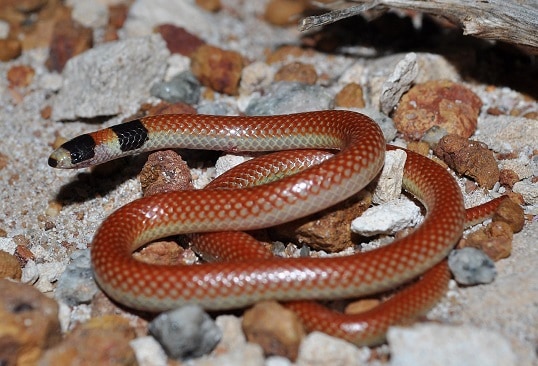
A small snake of southwest Australia, including the large city of Perth. This species is totally harmless to humans, and reaches a maximum length of 46.8cm. The black naped-snake (Narophis bimaculatus) requires soft soil to survive, as it’s rare to find them on hard ground like clay or granite. Hence, they’re typically found in intermediate semi-arid areas, such as dry shrubland, coastal heaths, coastal sand dunes and mallee woodlands.
Black-naped snakes love to take shelter under cover objects, burying themselves in soil or dried leaves. One of their special features is taking shelter in the abandoned nests of stick ants. Their diet includes reptiles almost exclusively, particularly skinks such as broad-banded sand-swimmers and common dwarf skinks. They also feed on legless reptiles such as sedgelands worm-lizards, which are easier to suck down than skinks (no legs is always a bonus).
Narophis bimaculatus is fairly easy to recognise, with a signature ID sign of a small black patch atop the head. This is followed by a larger black patch atop the lower neck. The tip of their snout is also black, as though dipped in paint.
This taxonomy of this species is constantly shifting. For decades, it was assigned to the Simoselaps genus, then Neelaps. As of 2023, it’s the sole member of the Narophis genus. Black-naped snakes overlap with the similar desert banded snake (Simoselaps bertholdi), but that species has alternating orange and black bands covering its whole body, not just the neck.
| 6 | Blackish blind snake |
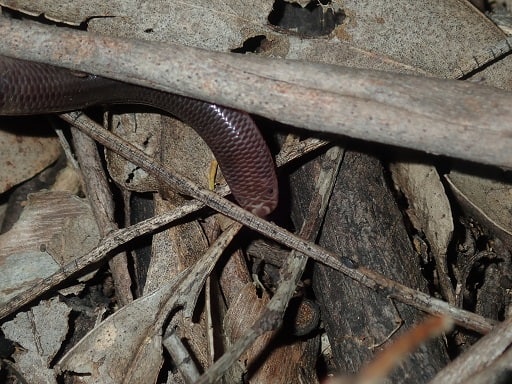
A common blind snake of eastern Australia, and a familiar species to local residents of Sydney and Brisbane. The blackish blind snake (Anilios nigrescens) spends the majority of its time underground, and its eyes have gradually shrunk in response to the diminished light. This species is a diehard ant-eater, which forces the swarming colonies into its mouth using a raking manouvre.
The blackish blind snake is completely harmless to humans. Its most “dangerous” weapon is a spiky tail which it pokes people with. Anilios nigrescens is one of the longer blind snakes worldwide, reaching a maximum of 75cm. However, they still fall victim to fellow Australian species, such as the small-eyed snake.
Blackish blind snakes are very discerning. They completely ignore the trails of earthworms and even termites, whereas trails of workers ants readily catch their attention. Popular prey include southern meat ants and banded sugar ants. Blackish blind snakes follow these trails back to the central ant colony, where they hit the motherload of mealtimes.
In a 1992 study, blackish blind snakes were able to follow scent trails that were weeks old as well as days old. However, they have some limitations, as they were poor at following the trails of individual ants, rather than commonly used pathways.
| 7 | Australian coral snake |
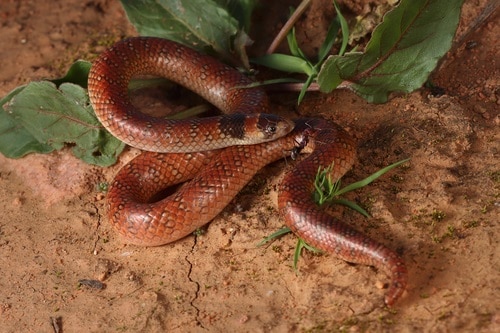
A 39cm snake (maximum 45cm) which avoids dense forests and prefers open woodland, dry grassland and arid scrubland. The Australian coral snake inhabits eastern Australia, but doesn’t hug the coastline like other species. It inhabits drier inland areas as well, such as gorges and dry creek beds.
Australian coral snakes (Brachyurophis australis) are identifiable by a jet black patch on the head, and then a second on the lower neck, combined with subtle white markings overlaying an orange body. Despite being an elapid like the tiger snake or eastern brown snake, their venom has been reduced down to nothing. The Australian coral snake is no threat to humanity as a whole, or individual explorers lost in a dry canyon. They rarely bite even if picked up and manhandled (though we don’t recommend this).
Australian coral snakes have specialised teeth, with a serrated edge. The purpose of this is slicing into its main prey, namely reptile eggs, and accessing the nutritious white and yolk within. These comprise the majority of its diet. They also have an adapted snout with an upturned edge, designed for digging up those leathery reptile eggs, by sifting through soil to find the hidden stashes.
The Brachyurophis genus is most closely related to the Australian Simoselaps genus, also mildly venomous. However, the two are believed to have diverged 18 million years ago. Brachyurophis likely split from the more dangerous brown snakes and death adders 23 million years ago.
| 8 | Black-striped snake |
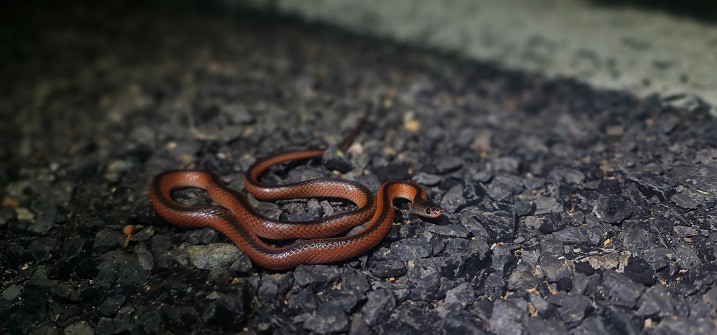
The black-striped snake (Cryptophis nigrostriatus) belongs to the same genus as the better known small-eyed snake (Cryptophis nigrescens), which lurks under rocks and eats a diet of 95% skinks. The black-striped snake lives further north, inhabiting Queensland exclusively, rather than east coast areas such as Sydney. It’s easily distinguishable from its cousin, due to its orange body overlaid with a thick black vertebral stripe.
Black-banded snakes average at 50cm, with a maximum of 62cm. Their habitats include woodlands and tropical sclerophyll forests, where they spend much of their life burrowing, often lurking in the upper 10cm of soil. Like their cousin, most of their prey consists of skinks.
Few case studies exist on their venom, but one victim was struck 3 times in quick succession by a black-striped snake. The effects were reported as “mild”, with the victim experiencing painful stomach cramps and stiffness similar to arthritis near the bite site. The small-eyed snake has killed one person on record (in 1965), so it’s conceivable that this snake holds secret dangers.
Black-banded snakes lay live young, typically in batches of size. The stripe varies with this species. In some, it’s clearly demarcated against the orange, while in other individuals it fades in more gradually.
| 9 | Variable black-naped snake |
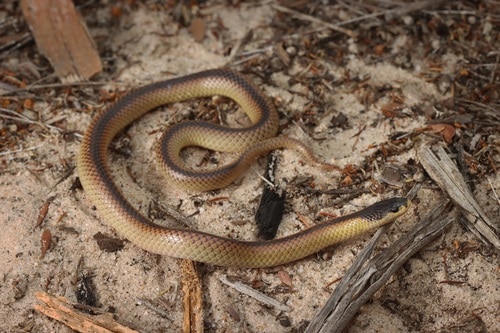
A small snake which ordinary Australians can easily walk past on a weekend trip through the woods. Variable black-naped snakes (Suta dwyeri) average at just 25-35cm, and inhabit eastern Australia, with a recognisable black head against an earthy-beige body. Their habitats include woodlands and dry sclerophyll forests, especially those with plenty of loose rocks and rocky outcrops.
This species is a big fan of shelter and cover objects. In the wild, they hide under rocks and fallen woodland debris, as well as abandoned mammal burrows. They’ve also been found on the outskirts of towns like Conargo, lurking under sheets of corrugated iron.
Suta dwyeri isn’t an aggressive snake, as when cornered, they prefer to coil up into a tight ball, protecting their most important body part: their brain. Their venom is mild and non-lethal, but be warned: they’re capable of leaving a deposited fang embedded in your finger.
One man was bitten on his right thumb just below the knuckle. The Suta dyweri hung on for 3-4 seconds, and 6 hours later, the man’s thumb stiffened, and the surrounding skin became sensitive to touch. The symptoms didn’t spread beyond the thumb, and they abated within days. Suta dwyeri virtually never strikes at people from a distance, but rapidly enters bite mode if picked up and manhandled. This is another reptile-eating snake, with prey including geckos and skinks.
| 10 | Red-naped snake |
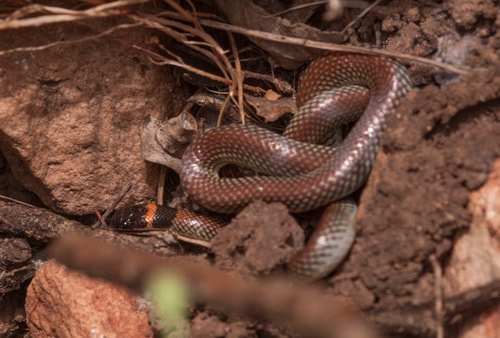
Australia has a disproportionate amount of snakes with orange-brown bodies, followed by a black head or neck. This list alone has several, but the red-naped snake (Furina diadema) has one clear ID sign: the namesake red patch between the two black patches higher up.
Red-naped snakes grow to a maximum of 45cm, and are especially common in suburban Brisbane. They sometimes fall into backgarden swimming pools, or are dragged through the cat-flap by feline pets. In urban areas, they can be found by ripping up sheet metal, assorted backyard rubbish and timber piles. In the wild, they can be found by rummaging through thick beds of leaf litter, which they love to lurk in, in order to pounce on unsuspecting skinks walking past.
This snake sometimes appears in communal formation, gathering in the same spot. Scientists visited a sheet of corrugated iron in Menangle, New South Wales 14 times over 32 months, and each time they found 6-8 red-naped snakes lurking comfortably below. They’ve also been found sharing hibernation sites with the yellow-faced whipsnake.
Staying out of sight is the red-naped snake’s top survival priority. This is a nocturnal species which will never be found striding through a sunny street during broad daylight, like an eastern brown snake. If frightened, they have two choices: 1) make repeated bluff strikes with their mouths closed, or 2) vanish into soil cracks. Bites are rare, though not unheard of, and their venom is mild.
